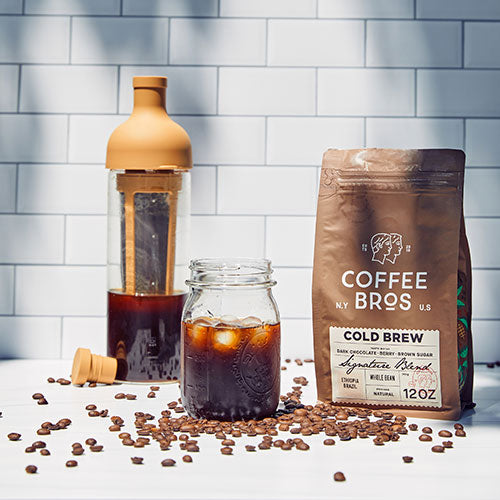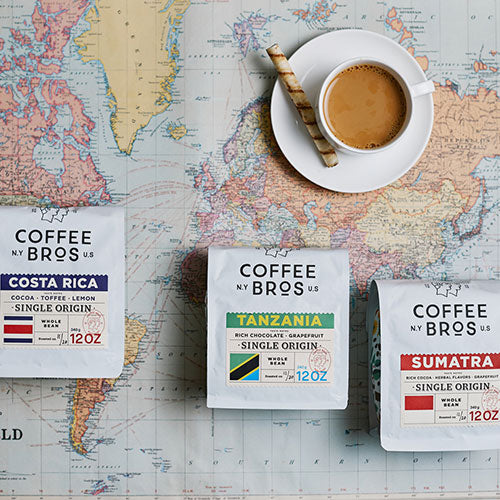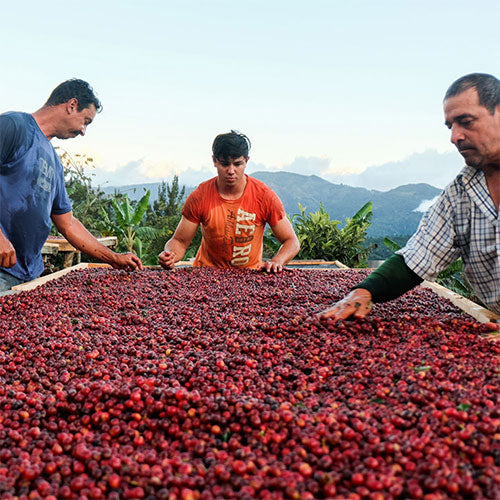There's a lot of pseudoscience out there around light roast coffee—and it makes it really hard to tell truth from fiction—but far more pressing is that moment when the barista asks you a question that leaves you confused:
Would you like a light or dark roast?
How different could they really be? You may be pleasantly surprised. Luckily, you don't need to be a barista or some kind of coffee sommelier to have a preference.
This guide seeks to help you discover the delicious and complex world of light roast coffee.
You'll learn things like:
- The wonderful world of light roast coffee flavor notes (most people have no idea)
- The truth about light roast caffeine content
- Why coffee pros often prefer light roast coffee
Next time you choose a coffee you will not only have a preference, but you may also have the knowledge to spare!
What Is A Light Roast Coffee?
Coffee roasting is the process of turning green coffee beans into brown ones. The easiest way to tell the different roasts apart is the color of the beans after roasting.
“Light roast coffee” refers to a coffee roasting style that produces light brown coffee beans with a matte surface. This roast style is used to retain the unique characteristics of the coffee bean. Unlike dark or medium roast coffees, the “roasty” flavor is subtle and similar to a toasted grain. Light roasts present a striking acidity, mellow body, and kaleidoscopic flavor.
Light Roast Coffee Is Basically Brand New
If roasting for the unique characteristics of a coffee seems like a new idea, that's because it is!
For most of coffee roasting history, beans were roasted dark on primitive roasters. Nothing special, it just needed to taste like “coffee”. You know what that means: bitter, thick, and slightly burnt. Flavors are strong enough to hide low-quality coffee and hold up to primitive brew methods.
Essentially, most coffee in history has tasted burnt!
But coffee science and technology have drastically improved in the last 50 years, and we have discovered a new world of coffee flavor.
- Selective breeding of coffee species has led to heartier plants
- Farmers across the globe are able to carefully monitor their crops and make adjustments in previously unimaginable ways
- Computers can help roasters track and control every temperature fluctuation in order to produce an exact result
Light roasts are the product of meticulous tweaking until we see the coffee's pull potential—a possibility that's brand new to the world of coffee. Thus, light roast becomes a coffee roasted gently enough that its natural flavors are able to blossom in the cup.
What Flavors Can I Expect From Light Roast Coffee?
Light roasts tend to astonish first-timers. You may hear things like, “how is this so good?” and “this is coffee?!”
The bold, fruity and floral flavor of a light roast coffee can be very exciting if you're used to drinking diner-style dark roast!
This is a result of the natural coffee bean flavors being retained through a gentler roasting process (AKA, not being burnt to a crisp). In addition to a subtle toasted grain flavor (a product of the roasting process itself) and crisp acidity, you can expect light roasts to have a combination of these flavors:
Sugar
- Honey
- Sugarcane
- Vanilla
Fruity
- Berry (strawberry, blueberry, raspberry)
- Citrus (lemon, lime, orange, grapefruit)
- Stone fruit (peach, plum, nectarine)
- Savory tomato or papaya
Floral
- Chamomile
- Rose
- Jasmine
The body (or the texture and weight of a coffee on your palate), is typically silky and light. Some light roasts can taste a bit like tea. This is pretty different from classic diner “mud” which is thick with oil and super dark, a result of using dark, oily beans.
All these flavors sound exciting and delicious, but we've come to one the drawbacks of light roast: it's a little more finicky to brew. Fear not! By taking the time to understand how these beans are different from a medium or dark roast, you will learn how to brew to draw out their flavor potential as well.
How Do I Brew Light Roast Coffee?
No secrets here! You can brew it just like you would a normal coffee. As with any coffee you're trying to get the best out of, pay attention to the basics:
- Grind size: ensure you select the right grind size for your brew method
- Water temperature: becauselight roast coffee has such dynamic flavor, it can be brewed at a variety of temperatures for different results.
- Contact time: the length of time you brew the beans affects the coffee extraction and changes the flavor. A pot of coffee can take 6 minutes to brew, while an espresso takes about 25 seconds.
- Freshness: as coffee ages, it oxidizes. Flavors alter considerably after the first few weeks. Use the freshest coffee possible in order to get the best flavor.
See our coffee brewing guide for more info on how to perfect your recipe.
What Do I Pair With Light Roast Coffee?
Light roasts are an exciting pairing with breakfast and afternoon snacks. You can count on dynamic fruit/floral flavor,easy body, and sparkling acidity. This pairs excellently with:
Creamy
- Buttery croissants
- Cheesy scones
- Avocado toast
- Lunch sandwiches
Tangy
- Thumbprint cookies
- Fruit pies
- Toast and jam
If you want to keep it simple, light roasts always taste great with just a splash of whatever creamer you're into.
Does Light Roast Coffee Have More Caffeine?
The myth: because light roast coffee beans are roasted less, they retain more caffeine.
The truth is, the caffeine difference between light and dark roast is insignificant.
There is something to the idea of coffee density, however—and it's the reason so many people get confused about this topic.
When talking about light vs. dark roast caffeine content, we should note that dark roasts lose density and the beans increase size in the roasting process (think—if you kept roasting, it would turn to ashes).
- If we measure coffee by volume (1 tablespoon), you'll have more individual beans of light roast coffee than dark roast, because the dark roast beans are literally bigger, and fewer can fit in the scoop. Thus, there would be more caffeine in the scoop of light roast.
- If we measure by weight (25 grams), the size of the beans doesn't matter—only the mass. So even though it would look like you had more dark roast beans (because they're bigger), you would actually have the same amount. The caffeine content would be roughly the same.
The caffeine content in the cup has much more to do with the brew method than the roast. When it comes to brew methods espresso is ounce-for-ounce stronger than drip coffee, but you drink less overall. Because espresso often has a heavy, thick taste similar to dark roast, people may associate the “strong flavor” of dark roast with “more caffeine”. Alas, it's just another myth.
See our article about how caffeine content stacks up between popular caffeine-based beverages.
Does light roast coffee have less acid?
Let's be straight: acid is a key component of coffee. Coffee without acid is like a cannoli with no cream—a hollow shell! No coffee is going to be acid-free, because the chemical reaction that produces coffee comes with a lot of acid.
Light roast coffees are high in ‘perceived' acid. That is, they can *taste* sour. That doesn't necessarily mean they have more acid. If you put less sugar in your lemonade, it's going to taste sourer. Darker roasts taste smooth and caramelly due to the longer roast process.
Certain varieties of coffee that grow as high altitude taste sweeter and can have less acid. Those coffees can be roasted light or dark. We offer a naturally low acid dark roast!
Cold brew coffee tends to be lower in acid because it bypasses the chemical reaction that releases acid from the beans. This is a great alternative for a light roast coffee drinker seeking less acid.
Is Light Roast Coffee Better Hot or Iced?
Light roast coffee can be enjoyed both ways!
Iced, it makes a mellow and sweet cold brew, or can be brewed double strength and served over ice to retain bright acidity and big flavor.
See our guide to cold brewing here.
Our light roast is particularly tasty brewed as an espresso, and also works great in any drip coffee machine or Chemex. Get ready for big floral notes!
Learn more about making espresso here.
Light vs. Medium Roast
Medium roast is roasted longer, with a darker bean color and no oil on the surface. You'll still find fruit notes, with a little bit of nuttiness and the essence of baking spices. Expect a more balanced, rounded flavor and more body in the cup. Medium roast is extremely versatile to brew but lacks the dynamic flavors of a light roast.
Our medium roast is a blend of coffees from Brazil, Ethiopia, and Colombia. Try it here!
Light vs. Dark Roast
Dark roast is roasted longer, with a much darker bean color and an oily surface. Flavors tend toward chocolate, caramel, maple and nuts. Dark roast is fantastic brewed espresso-style, in a french press, or regular coffee maker. It delivers a smooth acidity and bold flavor.
Sound like your cup of joe? Try our dark roast here.
Look For Light Roast In The Right Places
We happen to think we have some of the best light roast coffee beans around (even our friends at The Cozy Coffee think so!)
Our light roast is a 100% Arabica selection of coffees that we are excited about, roasted perfectly to reveal ambrosial notes of honey and citrus with a super silky body.



